Two historic buildings at 308-310 East Main Street are set for demolition under the watch of Todd Blue, but we should have seen this coming. The three-story brick and limestone buildings, excellent examples of vernacular architecture in Louisville, are apparently the sacrificial lambs of the Whiskey Row deal that saved five of the seven Landmarked buildings just down the street that Blue had previously sought to tear down.
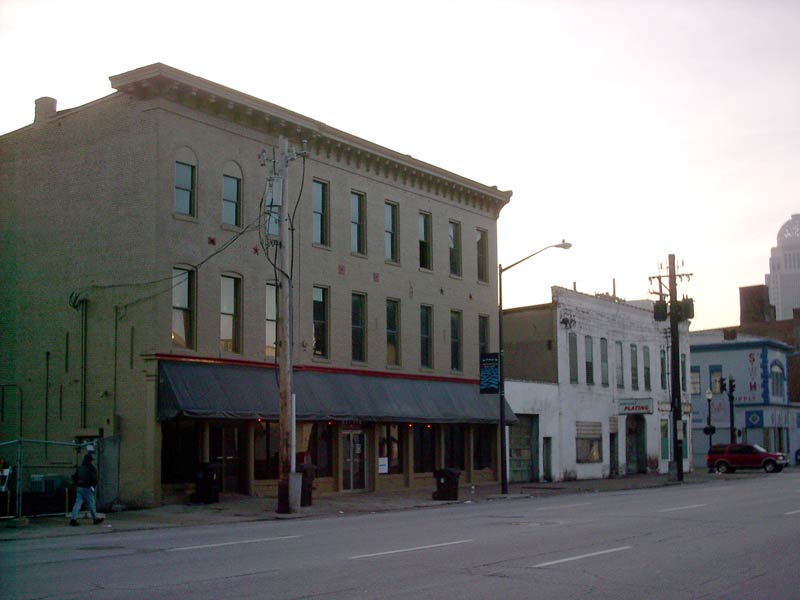
We first called out this set of buildings as endangered back in 2008 when Todd Blue first intended to demolish the structures and we notified preservation leaders in the community. It’s unclear why Blue did not follow through with demolition then, but luckily the buildings lasted past their first brush with death. Now painted head-to-toe in a nondescript beige that makes them seem to almost disappear from the street (perhaps the point), the buildings prewar examples in the two blocks between Floyd and Jackson streets (save Slugger Field).
“The only way to stop the demolition would be if the buildings were landmarked and then reviewed by the landmarks commission,” said attorney Stephen Porter, a prominent player in rescuing Whiskey Row. He said preservationists would most likely not fight for the preservation of these buildings as Todd Blue, who is fond of calling himself a great preservationist, could back out of the Whiskey Row deal, leaving eastern downtown literally in ruins. “That’s the deal the mayor made. I think he gave away the store here,” said Porter. “The most important thing is to save Whiskey Row.” Marianne Zickuhr of Preservation Louisville agreed saving these buildings would not be a preservation priority.
In fact, the Whiskey Row deal is contingent on the demolition of 308 East Main Street (along with demolishing two of the seven Whiskey Row buildings). Also part of the deal, the city is selling an adjacent vacant parcel to the east to Blue for $1, giving him a quarter of a block which will most likely remain a parking lot for years to come. Porter quipped that we may as well rename Possibility City to “Parkability City.”
Another group of two-story buildings, one featuring a cast-iron storefront, were demolished on the corner parcel owned by a group led by Blue at Floyd and Main streets in 2005. Blue had presented a development plan for the area at that time for a mixed-use condo and office development called The Hub. Renderings released then showed 308 East Main Street incorporated into the new complex. The Hub included a pair of five-story structures surrounding the 19th century buildings with a distinctive round corner.
The continued fallout of Todd Blue’s failed Iron Quarter project on the Whiskey Row block has left the prospect of preservation in Louisville in shambles. How many more buildings will be lost before this city realizes what it’s throwing away?
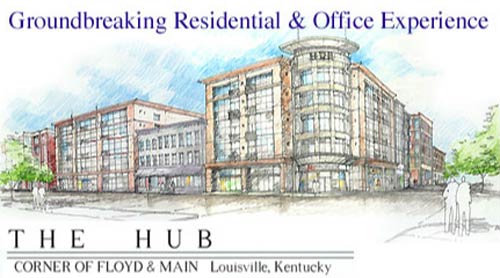



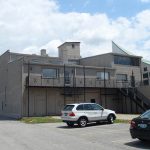

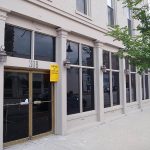

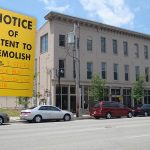


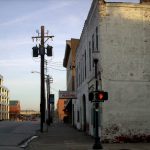

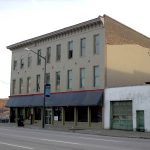
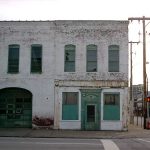
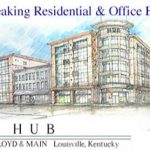

What a joke.
Don’t forget the parking spots in the 1st and Main parking garage that were part of the deal (value several hundred thousand dollars). Instead of holding up a bank and nabbing a couple hundred bucks, Blue held up the city and walked with milions.
So this area will also being a parking lot? Has there been any hint as to whether he has future plans for the site? Or if he is willing to sell? Is The Hub definitely dead? Mr. Blue is kind of a one man wrecking machine that has been set loose in Louisville, such a shame.
I can’t believe this. What the hell is Mr. Blue’s problem? Does he just not like historic architecture? Does he get off watching a building being reduced to rubble? Or does he just not care about the big architectural picture? I almost want to scream from frustration; having to watch what’s left of the old city be picked apart bit-by-bit is like being subjected to chinese water torture.
He’s probably hoping for the city to give them another big chunk of change to keep from tearing down these buildings that he did with Iron Quarter. Since the short term development market is basically dead because of the economy he’s using this system to continue to make money. For one
He’s probably hoping for the city to give them another big chunk of change to keep from tearing down these buildings that he did with Iron Quarter. Since the short term development market is basically dead because of the economy he’s using this system to continue to make money.
Has anyone put together a case for landmarking the buildings? Perhaps let’s see the case before we lament too much. Sometimes old buildings are key and historic, and other times they are just old. I’m not passing judgment either way at this time.
I don’t know that I care about that building, but I have yet to understand why anyone would knock down a perfectly good building for a parking lot.
He isn’t helping. He is negating the economic advantages of moving the basketball team from the fair grounds, arrested development of the waterfront…. He sure has established a certain reputation.
On what will we have to hang a billboard to remember the legacy of “Todd Blue’s Louisville?” A parking attendant booth?
I have been told that zoning and overlay make the creation of surface parking ‘illegal’ on Main Street – despite the precedent set by razing and paving of D&W Silks. Is that a way to stop this madness?
@Ken Wilson –
If this is the case than the one he is wanting to build was part of the Iron Quarter property should also fall under these regulations. I wonder if maybe they only applied to west main street? East main has the one you mentioned plus the one at Slugger Field already.
Why is there not a coordinated Historic Preservation Master Plan for the city? I don’t think that all old buildings need to be saved, but unless a prioritized plan is put together with a rationale for saving key buildings in the city, we are going to look like Charlotte… without the tall buildings, just empty parking lots when a basketball game is not going on.
We as a community need to be proactive about our heritage, not reacting when a building is threatened. Historic preservation might be a bit less contentious if everyone knew what buildings or areas were of value and why instead of hearing about the backlash of a demolition permit and thinking that every building that is on the chopping block is being fought against. Our city needs a “mix” of old and new, some buildings may need to go, but without getting too deep into location theory and economies of scale, last time I looked, there were a lot of missing teeth in our downtown as it is. Shouldn’t we try to fill those in before we start punching out more of our streetwalls?
Now that I have spent a few days cooling off and can write a little more intelligently (my apologies if my earlier comment seemed crude), my thoughts are this. I have to agree with Nick completely; the reason for my outrage is that Mr. Blue is taking a well-maintained building, located on Louisville’s main drag, and reducing it to rubble for no legitimate reason that I can see. If I remember correctly, the building underwent a $1 million renovation before he bought it in 2008; now three short years later its suddenly fit for the wrecking ball? I’m no economist, but wouldn’t it make more business sense to keep the building open and lease it? With the real estate market the way it is, “the Hub” probably won’t break ground for years, and in the mean time the site will be completely useless to both Mr. Blue and the general public. Mr. Magruder, I would love for the preservationist community to build a case for saving these buildings. But I think that the sad reality is that, until the Whiskey Row deal is finalized and those buildings are completely beyond the grasp of Cobalt Ventures, they will tread lightly around any of Mr. Blue’s activities. Otherwise, they risk having him throw a temper tantrum and backing out of that crucial deal at the last minute. All of that being said, I think this particular demolition is just the latest example of what I believe to be a potentially lethal trend. Mr. Magruder and Nick are both right; just about all these buildings have going for them is that they are old. But I think that they are just as important to the integrity of the Central Business District as some it’s grander landmarks. Without them, “important” places like Whiskey Row and West Main Street become isolated, islands in a sea of parking lots that is slowing rising. Just look at the block of Main Street in question; as little as eight years ago, there was stretch of old building all the way to the corner. No, they weren’t the best-looking buildings on Main Street; No, they weren’t in great shape. BUT THEY WERE THERE. The potential WAS THERE. Had those buildings been preserved and renovated, they could have been anything: bars, shops, specialty stores, studios, apartments, lofts. Now that potential is gone, and another patch of downtown is taken out of the picture. I realize that “The Hub” is a mixed-use project, but offices and luxury condos are two things that I think Louisville already has too much of. What’s more, these older buildings are unique; though they are plain, the simple brick detailing, the cast iron façade, and the vernacular style make them distinctly Louisville. Now they will be replaced by a building that, while well designed, is generic. It is because they easily fade into the background of Louisville architecture that buildings like this are often not protected and easily demolished. People find it easy to say “Oh, its just a plain looking warehouse/commercial building/townhouse/whatever, no one will miss it.” Born out of greed, ignorance, or a combination of the two, this indifferent attitude leads to the demolition of one building on a street, then another, and another. What happens when this pattern fully plays out? Louisville’s downtown is full of places where it has already happened, where sometimes only a single building remains on the empty footprint of what once an entire city block. Places like this send us a clear message: we can’t keep poking holes like this in Louisville’s streetscape. If we do, what little walkability is left in downtown will leak out onto the street and get washed down the river with the first good rain.
My faith in the ability of Louisville or this current administration to execute any plan that thwarts the desires of certain wealthy citizens to achieve what they want at the expense of the city is waning quickly.
All comments regarding the degrading streetscape are spot on, and frankly I am at a loss as to what Louisville’s “plan” is.
With a possible demolition only a couple days away, I believe there’s still an answered question here. Steve Porter and Marianne Zickuhr have both claimed (above even) that the Mayor has made an agreement with Blue not to oppose the demolition, yet they’ve never supplied any written documentation of such an agreement with their preservation partners. Suspicious? Well there’s more…
http://louisvillecourant.blogspot.com/2011/07/elmos-building-question-for-greg.html
a chain-link fence is up around the building. prep work has begun.
@curtis morrison – #@$%#%^&%#&%#^$&%^&*()*^(*!!!!
While I agree these buildings should be preserved, to FIRST way to protect these buildings would have been to 1) pony up the money to buy them and 2) spend the extra money to beautify them. Why didn’t anybody do that? I’m sure that Blue would sell them for an insane amount of money. The only way to truly protect historical buildings is to buy them yourself.
Buying them is not always a viable alternative nor should it be required. If proper historic districts we as appropriate regulations are formed by government buyers and owners of property know what will be required of them. If Anchorage can prevent trees from being removed without a viable reason and a permit metro government certainly should be able to present the demolition of historic structures. This is especially true for this case because there is actually no planned use for the property after the demolition.
Who cares. These buildings are not that remarkable. They are mediocre at best. Just because something is old doesn’t mean it is historic or valuable.
I look at the Genny’s Diner. They tore down that restaurant and are preserving the old house next door. They are putting in vinyl windows and are using cement siding. That building is now completely different than what it was when it was first built. The only thing is, it somewhat resembles an old building. But not really. If you look past the facade and dig into the bones of the building it is a new building. It does not resemble the building that was built originally any more.
It is like taking a model T and giving it a modern engine, modern brakes, modern safety gear, all the latest high tech gear you can imagine and then saying you are preserving history. It is ridiculous. It is a new building.
We are recreating a shallow facade of the past. A revisionist romanticized view of what history should have been. What buildings are we building today are going to be historic in 100 years from now? What legacy are we leaving? I will tell you none.